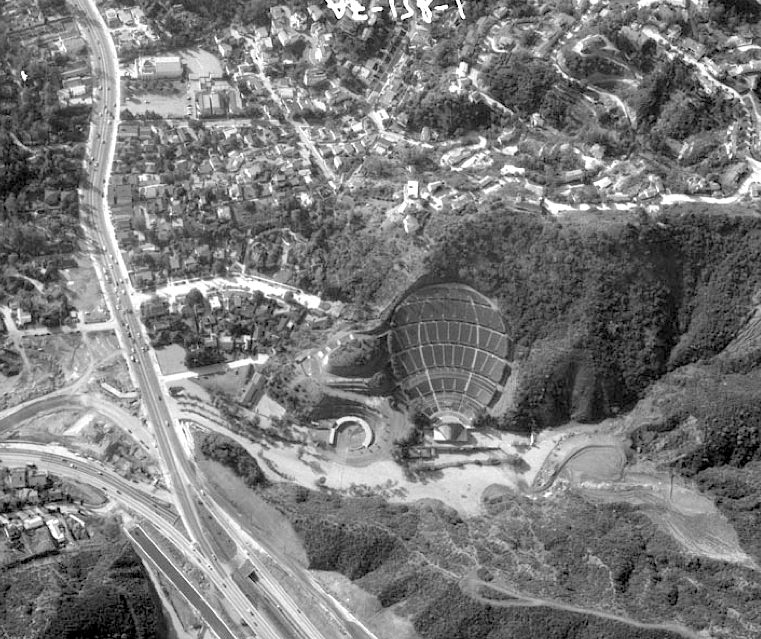Marilyn Monroe’s troubled childhood had a brief bright spot in 1933, when her mother Gladys purchased “a pretty little house” near the Hollywood Bowl at 6812 Arbol Drive.

The two-story stucco English home—built in 1925 by Hollywood architect Carl Jules Weyl (Baine Building with Henry L. Gogerty, Brown Derby on Vine Street)—had three bedrooms, portico entrance, shingle roof, garage, and plenty of surrounding land to play. Inside, there wasn’t much furniture aside from two cots to sleep on and a small kitchen table and chairs.
To lighten the financial burden, Gladys moved in an older couple she knew, George and Maude Atkinson and their teenage daughter Nell.

A few weeks later, Gladys came home from work with the first piece of purchased furniture for the house: a white baby grand piano she picked up at an estate sale for Dr. Jekyll and Mr. Hyde actor Frederic March.
Neither Norma Jeane nor her mother knew how to play, but the 8-year-old would take lessons, promised Gladys, who filled the child’s head with a dream scenario: “You’ll play the piano over here, by the windows, and here on each side of the fireplace there’ll be a love seat,” Marilyn recalled in her posthumous memoir My Story. “And we can sit listening to you. As soon as I pay off a few other things I’ll get the love seats, and we’ll all sit in them at night and listen to you play the piano.”

“But the two love seats were not to be,” revealed Marilyn. Gladys continued to struggle with her mental health, and put the house on the market in October 1934, but it didn’t sell.
In early 1935, one morning at breakfast, “there was a terrible noise on the stairway outside the kitchen. It was the most frightening noise I’d ever heard,” as if something, or someone, had fallen down the stairs. It was Gladys, “but you can’t see her,” warned Maude Atkinson.
An ambulance was called and when it arrived, Norma Jeane’s curiosity got the better of her. From the kitchen, she peaked out to see the commotion: “My mother was on her feet. She was screaming and laughing. They took her away to the Norwalk Mental Hospital. I knew the name of the hospital in a vague way. It was where my mother’s father and grandmother had been taken when they started screaming and laughing.”

The home and its furnishings were all liquidated, including the white piano. But she always remembered it. “I saw it in my mind every night as I grew up,” Marilyn told Ben Hecht decades later.
The Atkinsons took care of Norma Jeane for a brief period in 1935, although it’s unclear if they remained in the Arbol house until it sold or if they brought the girl to their next home, 2200 N. Highland directly across the street, where they lived until at least 1940.

Years later, after Norma Jeane married James Dougherty, she was driving through the area with her sister-in-law Elyda Nelson and pointe to Arbol Drive. “I lived there once, before mother was ill. It was beautiful. The most wonderful furniture you can imagine; a baby grand piano and a room of my own. It seems like a dream.”
When the actress was cast in Asphalt Jungle in 1950, she used her first week’s salary to search for the baby grand piano—and found it in a warehouse. “It was just as white and beautiful as ever,” she told Hecht. “I knew it was the same piano because Frederic March’s name was engraved on it. I bought it for $100 and took it home. It stood in my room for several years without a piano bench—just a white piano I couldn’t play.”

In 1999, the relic was auctioned off with a collection of Marilyn memorabilia and purchased by superfan Mariah Carey for $662,500.
“I didn’t want somebody to get it that didn’t understand that this was her childhood embodied… because it was her mom’s,” revealed the singer. “I kept everything the same. I didn’t want to change it. It’s even off-pitch… I’m not gonna redo it. Why would I do that?” When her manager balked at the price, Mariah insisted she didn’t care “because I didn’t want this to be exploited, because it’s her childhood.”

Back at the Hollywood Bowl, Marilyn’s childhood home stood proudly for another two decades, even as the area surrounding it swelled to capacity. In February 1954, three dozen homes in the area south of the Bowl and west of Highland Avenue were acquired by the county to make way for a massive parking lot for 1,500 cars.
That June, 6812 Arbol was advertised in the Los Angeles Times as a “must move” property, along with the neighboring 6820 and 6821 Odin Street, both of which were relocated (6820 still stands at 11343 Missouri Avenue). However, there is no paper trail for 6812 Arbol. Was it also moved before the bulldozers arrived?





